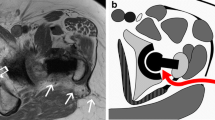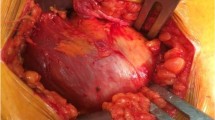Abstract
Introduction
The influence of surgical trauma on gluteus minimus muscle in total hip arthroplasty (THA) and the impact on functional outcome has been hardly investigated up to now. Potential risks of minimus damage during the approach or femoral preparation is due to its attachment to the anterior facet of the greater trochanter. Possible trauma-associated functional deficits of minimus muscle may result in reduced abduction force or in an unstable hip joint. The aim of the present study was to assess the pre- and post-operative gluteus minimus muscle (tendon defects and fatty atrophy) in patient with anterolateral minimally invasive and modified lateral approach by means of magnetic resonance imaging (MRI) and to investigate the associated impact on functional outcome.
Materials and methods
Thirty-eight patients [average age, 64 years (35–80); BMI, 28 kg/m2 (19–35)] with primary coxarthrosis were prospectively enrolled in the study. A cementless hip prosthesis was implanted either via a minimally invasive anterolateral or a modified direct lateral approach. Patients were clinically and radiologically (MRI) examined preoperatively, 3, and 12 months postoperatively. Additionally, the Harris hip score, a pain score (NRS 0–10) and a satisfaction score (1–6) were recorded. To test the function of the abductor muscles the Trendelenburg’s sign and the abductor muscle strength were evaluated. MRI evaluation includes the assessment of tendon defects and fatty atrophy of the minimus muscle.
Results
Tendon defects and fatty atrophy were seen in nearly 50% of the patients after THA. Harris hip-, pain-, and satisfaction scores did not correlate with the MR findings. There was also no impact on the abduction strength or the Trendelenburg’s sign. Furthermore, the frequency of minimus damage was neither influenced by age, gender, BMI nor by the applied approach.
Conclusion
Muscle atrophy and tendon defects of the minimus muscle appear frequently after THA without any favored relation to the lateral or anterolateral approach. The extent of injured minimus muscle has a minor impact on the clinical outcome particularly not on the abduction strength within the first postoperative year. The main function of the gluteus minimus is rather the centralization of the femoral head in the joint during the gait cycle than hip abduction and stabilization of the pelvis. The use of a straight stem with the associated need for lateral femoral preparation may be a risk factor for minimus tendon damage. Therefore, the surgeon should pay special attention to the prevention of surgical trauma to the gluteus minimus muscle during femoral preparation.




Similar content being viewed by others
References
Alonso J, Lamarca R, Marti-Valls J (2000) The pain and function of the hip (PFH) scale: a patient-based instrument for measuring outcome after total hip replacement. Orthopedics 23:1273–1277 (discussion 1277–1278)
Baker AS, Bitounis VC (1989) Abductor function after total hip replacement. An electromyographic and clinical review. J Bone Jt Surg Br 71:47–50
Bauer R, Kerschbaumer F, Poisel S et al (1979) The transgluteal approach to the hip joint. Arch Orthop Trauma Surg 95:47–49
Beck M, Sledge JB, Gautier E et al (2000) The anatomy and function of the gluteus minimus muscle. J Bone Jt Surg Br 82:358–363
Bertin KC, Rottinger H (2004) Anterolateral mini-incision hip replacement surgery: a modified Watson–Jones approach. Clin Orthop Relat Res, pp 248–255
Britton AR, Murray DW, Bulstrode CJ et al (1997) Pain levels after total hip replacement: their use as endpoints for survival analysis. J Bone Jt Surg Br 79:93–98
Dawson J, Fitzpatrick R, Murray D et al (1996) Comparison of measures to assess outcomes in total hip replacement surgery. Qual Health Care 5:81–88
Gogia PP, Christensen CM, Schmidt C (1994) Total hip replacement in patients with osteoarthritis of the hip: improvement in pain and functional status. Orthopedics 17:145–150
Gottschalk F, Kourosh S, Leveau B (1989) The functional anatomy of tensor fasciae latae and gluteus medius and minimus. J Anat 166:179–189
Goutallier D, Postel JM, Bernageau J et al (1994) Fatty muscle degeneration in cuff ruptures. Pre- and postoperative evaluation by CT scan. Clin Orthop Relat Res:78–83
Gray H, Bannister L, Berry M et al (1995) Gray’s Anatomy: the anatomical basis of medicine and surgery. Churchill–Livingstone, New York
Hardinge K (1982) The direct lateral approach to the hip. J Bone Jt Surg Br 64:17–19
Hollinshead W (1982) Anatomy for surgeons: the back and limbs. Lippincott Williams and Wilkins
Kamath S, Venkatanarasimha N, Walsh MA et al (2008) MRI appearance of muscle denervation. Skelet Radiol 37:397–404
Kumagai M, Shiba N, Higuchi F et al (1997) Functional evaluation of hip abductor muscles with use of magnetic resonance imaging. J Orthop Res 15:888–893
Mcmurray R, Heaton J, Sloper P et al (1999) Measurement of patient perceptions of pain and disability in relation to total hip replacement: the place of the Oxford hip score in mixed methods. Qual Health Care 8:228–233
Perka C, Heller M, Wilke K et al (2005) Surgical approach influences periprosthetic femoral bone density. Clin Orthop Relat Res, pp 153–159
Pfirrmann CW, Notzli HP, Dora C et al (2005) Abductor tendons and muscles assessed at MR imaging after total hip arthroplasty in asymptomatic and symptomatic patients. Radiology 235:969–976
Picado CH, Garcia FL, Marques W Jr (2007) Damage to the superior gluteal nerve after direct lateral approach to the hip. Clin Orthop Relat Res 455:209–211
Potter HG, Nestor BJ, Sofka CM et al (2004) Magnetic resonance imaging after total hip arthroplasty: evaluation of periprosthetic soft tissue. J Bone Jt Surg 86-A:1947–1954
Ralston HJ, Inman VT et al (1947) Mechanics of human isolated voluntary muscle. Am J Physiol 151:612–620
Twair A, Ryan M, O’connell M et al (2003) MRI of failed total hip replacement caused by abductor muscle avulsion. AJR Am J Roentgenol 181:1547–1550
Wilson GL, Capen EK, Stubbs NB (1976) A fine-wire electromyographic investigation of the gluteus minimus and gluteus medius muscles. Res Q 47:824–828
Author information
Authors and Affiliations
Corresponding author
Rights and permissions
About this article
Cite this article
Müller, M., Tohtz, S., Winkler, T. et al. MRI findings of gluteus minimus muscle damage in primary total hip arthroplasty and the influence on clinical outcome. Arch Orthop Trauma Surg 130, 927–935 (2010). https://doi.org/10.1007/s00402-010-1085-4
Received:
Published:
Issue Date:
DOI: https://doi.org/10.1007/s00402-010-1085-4




